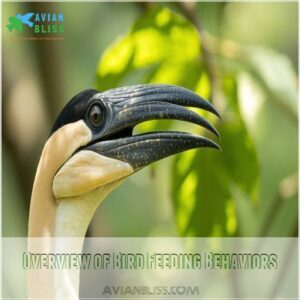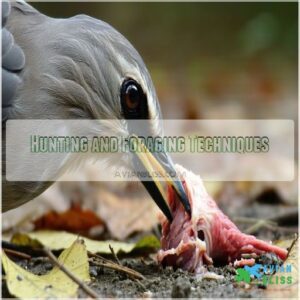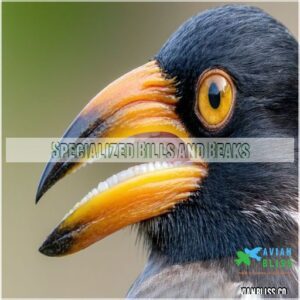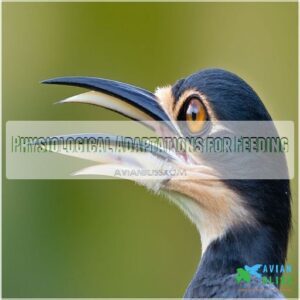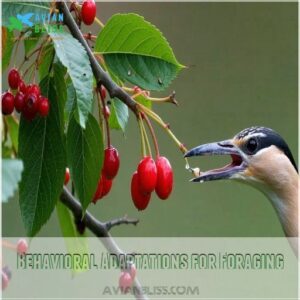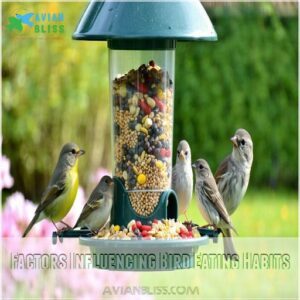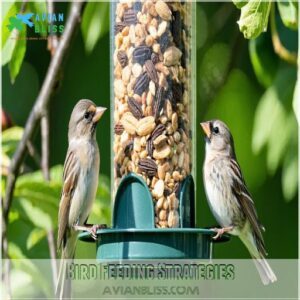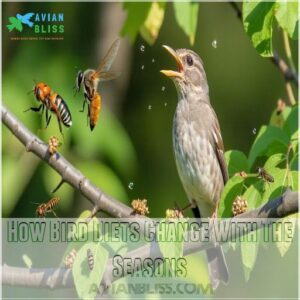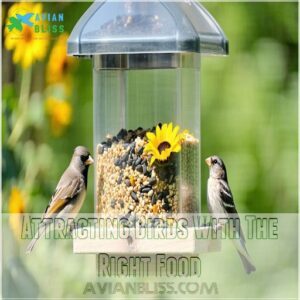This site is supported by our readers. We may earn a commission, at no cost to you, if you purchase through links.

Imagine your favorite restaurant having a seasonal menu—birds experience something similar!
During spring and summer, insectivorous birds feast on plentiful insects.
As autumn arrives, seeds and fruits become essential for many species like herbivores and omnivores.
These changes are crucial for their survival and showcase their adaptability.
Understanding these shifts helps us appreciate birds’ roles in ecosystems and how environmental factors affect them.
So, if you’re looking to attract more birds to your backyard, consider offering meals that match the season.
Curious about which foods might work best?
Let’s explore further!
Table Of Contents
- Key Takeaways
- Overview of Bird Feeding Behaviors
- Types of Bird Feeding Behaviors
- Bird Feeding Adaptations
- Factors Influencing Bird Eating Habits
- Bird Feeding Strategies
- How Bird Diets Change With The Seasons
- Attracting Birds With The Right Food
- Frequently Asked Questions (FAQs)
- Do different diets affect birds’ behavior?
- What factors affect a bird’s appetite and feeding behavior?
- Why do birds eat a lot?
- Do dietary habits of birds affect the evolution of species?
- Do diet preferences influence bird diversification?
- Why is responsible bird feeding important?
- Why is my bird eating more than usual?
- Why do birds suddenly stop eating?
- What determines the feeding habits of the birds?
- Should I stop feeding the birds?
- How do urban environments affect bird diets?
- What triggers birds to switch food sources?
- How do climate changes impact bird eating patterns?
- Why do some birds eat more than others?
- How does food scarcity influence bird behavior?
- Conclusion
Key Takeaways
- You’ll notice that birds adjust their diets with the seasons, relying on insects in spring and summer and switching to seeds and fruits in autumn and winter.
- By understanding the birds’ dietary needs, you can attract more birds to your backyard by offering seasonal foods like suet in winter and fruits in summer.
- Feeding birds responsibly supports healthy ecosystems, maintaining their natural foraging behaviors and preventing dependency on artificial food sources.
- Environmental changes, like climate change and urbanization, force birds to adapt their eating habits, highlighting their ability to survive and thrive in evolving conditions.
Overview of Bird Feeding Behaviors
You’ll discover that birds display a fascinating variety of feeding behaviors, from the acrobatic catches of a flycatcher to the careful probing of a woodpecker.
Understanding these behaviors is key to appreciating the diverse roles birds play in their ecosystems and how we can best support them.
Importance of Studying Bird Diets
Understanding bird diets is key for conservation and healthy ecosystems.
You’ll appreciate the magic behind their foraging behavior:
- It reveals bird dietary adaptations and food preferences.
- It helps track bird eating habits and diet changes.
- It illuminates species interactions and population dynamics.
These insights guide efforts to balance food production with ecological harmony.
Impact of Bird Feeding on Ecosystems
Bird feeding isn’t just about keeping our feathered friends happy; it’s like helping an intricate dance within ecosystems.
The seeds you choose for your bird feeder can shift bird feeding patterns, impacting food chains and even inviting invasive species.
Offering native bird food sources like seeds and fruits can greatly influence these patterns.
Changes in bird diets ripple through their habitats, affecting bird food availability and preferences, ultimately shaping our natural world.
Drivers of Bird Evolution
Imagine bird evolution as nature’s grand buffet. The changing environment pushes these feathered diners to adapt their eating habits. Factors like competition and climate change stir up the menu, impacting food availability and habitat loss. With natural selection at play, bird foraging behavior transforms, sporting new dietary adaptations.
- Natural selection shapes bird diets.
- Habitat loss pressures feeding habits.
- Climate change tweaks food sources.
- Birds adapt through foraging innovations.
Types of Bird Feeding Behaviors
Birds showcase an array of feeding behaviors, from hunting and foraging to specialized diets that suit their ecological niches.
You’ll find some peering into the water for fish or scoping out seeds on the ground, illustrating their remarkable adaptability across different environments.
Hunting and Foraging Techniques
When birds hit the buffet, they bring creativity to the table.
Using foraging techniques like camouflaging among leaves, some evade predators while others engage in cooperative hunting—a scene straight from a marketing playbook.
Defending territories or homesteads with cunning nesting strategies, these winged wonders aren’t just peckish travelers; they’re masters at adapting bird feeding patterns to local foraging grounds.
Dietary Preferences and Specializations
Every bird poker face reveals unique dietary preferences.
Birds have specialties, much like choosing a favorite restaurant menu item.
Notably, these preferences are often influenced by seasonal availability of food sources, with birds changing their diets to adapt to the environment, as seen in various bird diet variations.
- Granivores: Seed fanatics who crush grains with tough beaks.
- Frugivores: Fruit-loving connoisseurs savoring nature’s candy.
- Insectivores: Bug-catching maestros, patrolling gardens.
- Carnivores: Fierce hunters targeting flesh.
- Omnivores: Eclectic eaters mixing prey and plants.
Each niche highlights nature’s adaptive genius.
Adaptations for Aquatic and Terrestrial Feeding
So, you’ve learned about different bird diets; now let’s see how they adapt to where they find food.
Birds show amazing changes based on their environment.
Check out these key differences:
| Feature | Terrestrial Bird | Aquatic Bird | Aerial Bird |
|---|---|---|---|
| Bill Morphology | Strong, conical for seed-cracking | Long, pointed for spearing fish | Short, hooked for catching insects |
| Foraging Techniques | Hopping, scratching | Diving, swimming, wading | Flying, hovering, aerial pursuit |
| Adaptations for swimming | None | Webbed feet, waterproof feathers | Streamlined body, powerful wings |
| Predator Avoidance | Camouflage, quick escape | Diving, underwater hiding, schooling behavior | Speed, agility, high-altitude flight |
These adaptations help birds survive in different habitats, showcasing nature’s ingenuity.
Bird diet changes are heavily influenced by these adaptations.
Bird Feeding Adaptations
Birds have evolved unique adaptations to handle a wide variety of foods, from the hooked beaks of hawks for tearing meat to the long bills of hummingbirds for sipping nectar.
Feeding behaviors are perfectly tuned to their environments, whether it’s foraging on the ground or catching fish in mid-flight.
Specialized Bills and Beaks
Birds’ eating habits shift as their beaks evolve into effective tools suited to their food preferences.
Imagine a toolbox in a bird’s beak:
- Sword-like spears in kingfishers for fishing adventures.
- Nut-cracking pliers in parrots for high-protein meals.
- Seed-crushing hammers in finches for opening tough shells.
Each unique design showcases nature’s genius in shaping bird diet adaptations.
Physiological Adaptations for Feeding
Imagine this: your favorite bird with a beak as versatile as a Swiss army knife!
Birds have evolved intricate digestive systems to process diverse food types efficiently.
High metabolism rates help turn food into energy swiftly, accommodating their active lifestyles.
Bird beak evolution tailors to dietary adaptations, ensuring they meet nutritional needs, especially with seasonal diet shifts.
By understanding bird feeding adaptations, you can create a more welcoming environment for birds in your backyard with the right bird feeding options.
Behavioral Adaptations for Foraging
Imagine you’re a bird at brunch, facing a buffet of choices.
Birds adapt not just physiologically but also through brilliant behavioral strategies, such as adapting their foraging strategies to avoid competition like ground feeders do on the ground feeding methods.
Think about foraging techniques that focus on foraging flexibility, tool use like the crow with sticks, or clever predator avoidance tactics.
These adaptations help them navigate diverse environments, fine-tuning their bird feeding behaviors to fit changing landscapes.
Factors Influencing Bird Eating Habits
You’re probably curious about what changes bird eating habits, right?
Seasonal food availability, human activities like urban development, and various environmental factors all play significant roles in influencing what birds decide to munch on.
Seasonal Changes in Food Availability
Those amazing beaks aren’t just for show! A bird’s diet changes wildly with the seasons. Think about it:
- Winter: Food’s scarce, so they gobble high-energy foods like seeds and suet to survive.
- Spring: Insect abundance explodes, perfect for hungry chicks.
- Summer: Seed availability is high, supplementing their insect diets.
- Fall: Bird migration begins, fueling up for long journeys.
Their eating habits shift to match what’s around.
Human Influence on Bird Feeding Behaviors
Our actions greatly affect bird feeding behaviors. From backyard bird feeders to habitat loss, we alter their food preferences and consumption patterns.
Climate change impacts food availability, forcing birds to adapt their feeding strategies.
Consider these influences in your backyard:
| Factor | Impact on Birds |
|---|---|
| Bird Feeders | Alters natural diet |
| Habitat Loss | Limits food sources |
| Climate Change | Changes food access |
| Urbanization | Shifts feeding habits |
| Pollution | Affects food quality |
Environmental Factors Affecting Bird Diets
Shifting habitats impact bird eating habits, so pay attention to climate change, habitat loss, and pesticide use.
These factors trigger food scarcity, altering bird food preferences and availability.
Invasive species further complicate seasonal bird diets.
As ecosystems change, bird food changes follow, forcing birds to adapt swiftly.
Understanding bird food availability’s impact helps protect these delicate creatures from environmental challenges.
Bird Feeding Strategies
When you think about bird feeding strategies, consider self-control and foraging flexibility, which are like balancing acts in nature.
Birds adapt their diets and behaviors through exploration and cooperation, demonstrating remarkable ingenuity in how they find and use food.
Self-Control and Foraging Flexibility
Think about birds’ ability to exercise self-control and flexibility when foraging.
It’s like choosing between sticking to a diet or indulging in a tempting treat.
Birds demonstrate cognitive evolution by adapting their foraging strategies, juggling food preferences and competition.
This adaptability helps them thrive amid environmental changes, showcasing clever feeding strategies that guarantee they find food despite challenges.
Exploration Behavior and Personality Traits
Imagine watching birds switch food sources like they’re trying a new restaurant.
Their exploration behavior and personality traits play a huge role here.
Birds with high curiosity and adaptability often embrace new diet changes effortlessly.
Traits such as:
- Risk-taking in exploring new areas
- Natural innovativeness in finding food
- Intelligence driving foraging strategy
keep their feeding flexible and interesting.
Cooperative Feeding and Tool Use
Cooperative feeding shows real bird teamwork.
You’ll find birds like crows and woodpeckers using tools for meals, a unique twist in their feeding strategies.
Check this out:
| Species | Example of Tool Use | Cooperative Behavior |
|---|---|---|
| Crows | Sticks for insects | Sharing food sources |
| Woodpeckers | Beak as a chisel | Alarm signaling |
| Herons | Bait fishing | Group hunting |
| Parrots | Leaves as sponges | Nest building cooperation |
| Gulls | Dropping shells | Coordinated flocking |
How Bird Diets Change With The Seasons
You’ll find that a bird’s diet isn’t a static thing; it changes dramatically throughout the year, adapting to the seasonal availability of different food sources like insects, seeds, and fruits.
Think of it as their own personalized, nature-driven meal plan, shifting from high-energy snacks in winter to nutrient-rich meals for nesting in spring.
Winter Feeding Strategies
As winter’s chill grips your backyard, adapt your bird feeding strategies to help wild birds thrive.
High-energy winter bird foods like seed blends and suet feeders are essential.
These supplies provide essential fats and nutrients that backyard birds need for winter survival.
Think of it as laying out a feast to fuel their tiny, resilient bodies through the cold.
Spring Migration and Breeding Diets
During spring, the diets of birds undergo significant changes, adapting to migration routes and ensuring nestling needs are met.
They often face increased food competition, making energy storage essential.
Available food shifts, prompting dietary adaptations.
As migration and breeding demands rise, birds require potent diets to fuel their journeys and support their young, swapping winter staples for rich, diverse sources.
Summer and Fall Foraging Behaviors
Picture birds feasting on a summer buffet—abundant seeds and insects galore.
As daylight wanes and fall creeps in, migrating birds adjust their diets for energy-packed foods, often requiring a bird diet change.
You might notice shifts in seed preferences and increased insect foraging.
These changes help them navigate changing habitats and migration patterns, adapting their feeding behaviors to seasonal diets until winter beckons.
Attracting Birds With The Right Food
Attracting birds to your backyard can be easy and rewarding if you know what foods to offer.
By choosing the right bird seed and adding fruits, insects, and water, you’ll support local bird populations and enjoy their vibrant presence year-round.
Choosing The Right Bird Seed
To attract a variety of birds, choose the right bird seed types.
Seed mixes cater to different bird preferences and eating habits.
Black oil sunflower seeds, for instance, are a favorite among many species due to their high nutritional value.
Place feeders wisely, considering feeder types and seed placement to accommodate bird dietary adaptations and encourage diverse bird food consumption.
Supplementing With Fruits and Insects
So, you’ve mastered birdseed; great job! Now, let’s talk fruit and insects. These natural supplements add variety to your bird’s diet, boosting their foraging flexibility. Here’s what to offer:
- Bird-friendly fruits like berries and melon chunks.
- Mealworms, a protein powerhouse.
- You can find specialized products online, like bird feeder insects, to help attract various species.
- Caterpillars (if you can stomach it!).
- Avoid anything treated with pesticides.
These additions enhance your backyard biodiversity and help birds adapt to seasonal changes in their bird eating habits.
Providing Water and Suet for Birds
Ever wonder why birds flock to your garden? Access to water and suet is key.
Water source types like birdbaths attract thirsty visitors.
Give suet a try; it’s rich and energy-packed—perfect for cold days.
Experiment with suet recipes like peanut butter blends.
Place feeders wisely to prevent unwanted guests.
Remember the dos and don’ts of bird feeding strategies, keeping it natural.
Frequently Asked Questions (FAQs)
Do different diets affect birds’ behavior?
You’re skeptical, but different diets impact birds’ behavior considerably.
Food choices dictate feeding habits, migration patterns, and interaction with other species, adjusting survival tactics.
Like us choosing pizza or salad, diet shapes their daily actions and survival strategies.
What factors affect a bird’s appetite and feeding behavior?
Birds’ appetite and feeding behavior hinge on food availability, season, and lifecycle stage.
Competition, habitat change, and physiological needs also play roles, shaping how they forage and what they eat in their ever-adapting search for sustenance.
Why do birds eat a lot?
Think birds are overeating?
Actually, they need to maintain high energy levels for flying, foraging, and staying warm.
Birds eat a lot because their tiny bodies burn through calories quicker than a brisk walk on a cold day.
Do dietary habits of birds affect the evolution of species?
Dietary habits strongly shape bird evolution. What birds eat directly impacts their beak shape, digestive systems, and even their behavior. This constant adaptation promotes survival and species diversification.
Do diet preferences influence bird diversification?
Ever wonder how bird species diversify?
Diet preferences lead to adaptations in beaks and behaviors, driving evolutionary changes.
This diversity in feeding habits enables birds to thrive in different environments, contributing to their extensive diversification.
Why is responsible bird feeding important?
Responsible bird feeding helps maintain healthy ecosystems by supporting bird populations without disrupting natural foraging behaviors.
Providing appropriate food can enhance biodiversity while ensuring birds don’t become dependent on artificial sources, keeping their natural instincts intact.
Why is my bird eating more than usual?
Your bird’s increased appetite might signal changes in its lifecycle, like molting or preparing for colder weather.
Stress or health issues could also be indicated.
Monitor its behavior and consult a vet if concerns persist.
Why do birds suddenly stop eating?
Birds might stop eating due to stress, illness, changes in food availability, or environmental shifts.
They’re sensitive to new surroundings or disturbances, so observe them closely and consult a vet if the behavior persists.
What determines the feeding habits of the birds?
Feeding habits of birds hinge on diet availability, adaptability, competition, and environmental conditions.
They’re shaped by evolution, leading to specialized beaks and behaviors, letting birds adapt to specific niches like foraging, hunting, or opportunistic feeding.
Should I stop feeding the birds?
If it looks like nature’s on a hiatus and food’s scarce, your backyard buffet might just be a lifesaver.
Keep feeding birds, especially in harsh seasons.
Unless they face risks like disease spread at feeders.
How do urban environments affect bird diets?
Urban areas offer birds readily available, often unnatural food sources like scraps and feeder food, altering their natural diets and potentially impacting their health and survival.
This shift can also change their foraging behaviors and interactions with other species.
What triggers birds to switch food sources?
Birds switch food sources due to availability, seasonal changes, competition, or nutritional needs.
Just like changing your menu at home when ingredients run low, they adapt to what’s accessible, ensuring they get the best nutrition.
How do climate changes impact bird eating patterns?
Worried about climate change altering your feathered friend’s diet?
Shifting temperatures and irregular weather patterns push birds to adjust their feeding habits, seeking new food sources as their usual habitats and resources evolve.
Why do some birds eat more than others?
Some birds eat more than others because of differences in energy needs, metabolic rates, and activities.
For example, a hummingbird’s rapid wing beats require extra fuel, while a larger bird might need more food for body maintenance.
How does food scarcity influence bird behavior?
When food becomes as scarce as unicorns, birds adapt by changing migration, diet, and foraging techniques.
They may travel further, switch to new food sources, or develop new behaviors, demonstrating remarkable flexibility under pressure.
Conclusion
Curious about what makes birds so adaptable?
As bird eating habits change with each season, they reveal fascinating survival tactics and emphasize their critical roles in ecosystems.
By understanding these dietary shifts, you not only enrich your backyard birdwatching but also support their adjustments through various seasons.
Whether it’s offering suet in winter or seeds in fall, you can actively participate in their natural cycles, making your space a haven for their evolving needs.

